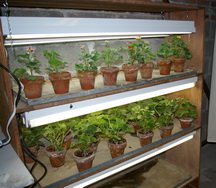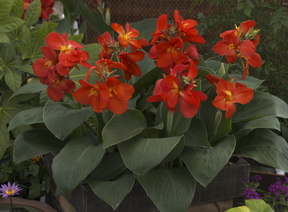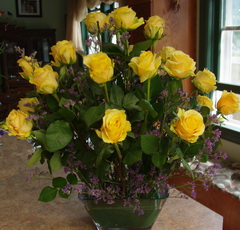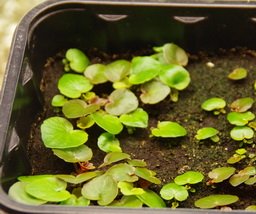| Back to Back Issues Page |
 |
|
Dallying In The Dirt, Issue #122 --- The Begonia boliviensis are growing and Valentines is coming. February 13, 2013 |

My holiday from writing has been wonderful but maybe a bit too long. “ Dallying In The Dirt” should now return to its somewhat regular biweekly pattern. Not writing about the garden certainly does not mean that nothing was happening. We spent a week in Florida with some grandchildren, attempting to get them out of the swimming pool and learn the names of the Palm trees around it. Limited success! Maybe 3 is too young to care about such things when the water is warm and the sun is bright. I did appreciate some of the specimens but then I have always had a thing for Palm trees. That probably has something to do with their complete inability to survive in my corner of the world. I do have a significant photo collection of Palm species.  I’m busy sorting all of my seeds into their respective planting times so that I just have to follow my calendar for the rest of the seeding season. I usually throw out any seeds that are more than two years old. I know that many of them would still have a reasonable germination percentage but dealing with a 50% germination rate is just too frustrating. Tomato seed is usually quite viable for 10 years or more, which I find quite amazing. I need to get busy and finish ordering any new seed that I need for this year and also a few that are new and that I don’t actually need. Separating need from want is always difficult for a gardener wandering through a seed catalogue.
I’m busy sorting all of my seeds into their respective planting times so that I just have to follow my calendar for the rest of the seeding season. I usually throw out any seeds that are more than two years old. I know that many of them would still have a reasonable germination percentage but dealing with a 50% germination rate is just too frustrating. Tomato seed is usually quite viable for 10 years or more, which I find quite amazing. I need to get busy and finish ordering any new seed that I need for this year and also a few that are new and that I don’t actually need. Separating need from want is always difficult for a gardener wandering through a seed catalogue.  The Geraniums that were started as cuttings last fall are thriving under the lights. They are crowding their space and it is time to make some more cuttings from them. That process will give me many more plants and encourage the mother plants to be thicker and bushier. My Geranium success this year has been a little too good and I am finding myself with an overabundance of nice healthy plants. While one cannot have too many plants, one can have too little space. I really don’t want to fire up the outdoor hot frame just yet, mostly because it has 30 - 40 cm of snow sitting on it. Cutting back these plants will make them use up less space and the cuttings will go in the propagation bed which still has lots of room in it. Problem solved, until the cuttings take root and want a space of their own.
The Geraniums that were started as cuttings last fall are thriving under the lights. They are crowding their space and it is time to make some more cuttings from them. That process will give me many more plants and encourage the mother plants to be thicker and bushier. My Geranium success this year has been a little too good and I am finding myself with an overabundance of nice healthy plants. While one cannot have too many plants, one can have too little space. I really don’t want to fire up the outdoor hot frame just yet, mostly because it has 30 - 40 cm of snow sitting on it. Cutting back these plants will make them use up less space and the cuttings will go in the propagation bed which still has lots of room in it. Problem solved, until the cuttings take root and want a space of their own. What new varieties might I be trying this year. A good source of information is the All America Selections testing site. They have trial grounds all over N. America and award their A.A. Selections to vegetables and flowers that can be grown from seed and grow better then older varieties in all areas. Although the testing program remains very good their release dates and information are not as good as they used to be since a recent reorganization. It took me sometime on their website to find this year’s winners and even longer to find out where I might be able to purchase seed. Many of the winners were not widely available which is somewhat disappointing after you have read all about them. I will be trying a new Canna “South Pacific Scarlet” that can be grown from seed if planted in February. A new cherry Tomato, “Jasper”, bred by Johnny’s is also on my list. Both of these are available in Canada from Dominion Seed House.
Every catalogue has its own list of new varieties and all the descriptions sound wonderful. How do I get the job of writing variety descriptions for a seed catalogue??
What new varieties might I be trying this year. A good source of information is the All America Selections testing site. They have trial grounds all over N. America and award their A.A. Selections to vegetables and flowers that can be grown from seed and grow better then older varieties in all areas. Although the testing program remains very good their release dates and information are not as good as they used to be since a recent reorganization. It took me sometime on their website to find this year’s winners and even longer to find out where I might be able to purchase seed. Many of the winners were not widely available which is somewhat disappointing after you have read all about them. I will be trying a new Canna “South Pacific Scarlet” that can be grown from seed if planted in February. A new cherry Tomato, “Jasper”, bred by Johnny’s is also on my list. Both of these are available in Canada from Dominion Seed House.
Every catalogue has its own list of new varieties and all the descriptions sound wonderful. How do I get the job of writing variety descriptions for a seed catalogue??  St. Valentine was apparently a third century Catholic saint that died on 14 February. Little else is know about him, but the card, flower and chocolate industries have seized upon a later association with courtly love attributed to him, to generate one of their best profit making holidays of the year. In a masterpiece of branding and marketing every male in N. America is made to feel guilty if he doesn’t spend $50+ for some roses that would cost $20 on any other day of the year. I do admit to having made a few dollars myself, in past years, from this feeding frenzy. Shed a tear for the Assistant Gardener who will have to make do with the Orchids, Cyclamen and Amaryllis presently blooming in our house. She reciprocates by being out of town on business. Here’s a nice picture of Roses to help you celebrate.
St. Valentine was apparently a third century Catholic saint that died on 14 February. Little else is know about him, but the card, flower and chocolate industries have seized upon a later association with courtly love attributed to him, to generate one of their best profit making holidays of the year. In a masterpiece of branding and marketing every male in N. America is made to feel guilty if he doesn’t spend $50+ for some roses that would cost $20 on any other day of the year. I do admit to having made a few dollars myself, in past years, from this feeding frenzy. Shed a tear for the Assistant Gardener who will have to make do with the Orchids, Cyclamen and Amaryllis presently blooming in our house. She reciprocates by being out of town on business. Here’s a nice picture of Roses to help you celebrate. Time to answer a few questions. If you have a gardening question just ‘reply’ to this newsletter and send me your query. I try to answer most of the questions and the ones that I answer here are those that I think will have the widest interest. You can also find the latest garden updates on the front page of gardening-enjoyed.com. |
| Back to Back Issues Page |
 The
The